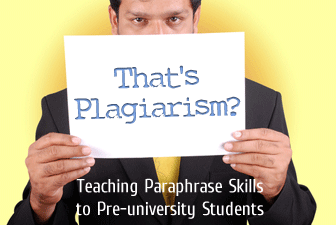
Learning how to paraphrase another’s words is difficult for any writer, even more so for nonnative speakers who come from countries that don’t have any concept of plagiarism.
Many EFL students want to attend a U.S. university; however, they lack the academic skills to write college level papers which involve research. Even if you teach students who don’t need to do academic research, paraphrasing and summarizing are beneficial tools for reading comprehension. Below are some ways to teach your students the valuable skill of paraphrasing.

How to Teach Paraphrase Skills to Pre-university Students
-
1
Explain plagiarism
As many countries don’t have intellectual copyright laws, many students don’t understand the concept of giving credit to an idea that didn’t come from them. Use concrete illustrations of “stealing” to help them see the connection. For example, you present the scenario that the students work together to make food at a restaurant. How would they feel if someone used their food without paying for it? Then move to more abstract notions, such as music and movies. How would they feel if someone used the songs which they wrote, and they never got any money for them? Finally, move to ideas and show them how stealing someone else’s’ idea is related to stealing someone’s work, even though there is no physical product that you can touch. Regardless if they agree or disagree that intellectual property deserves to be protected, explain that most universities feel this way and they can be in trouble if they don’t take plagiarism seriously.
Next, it’s important to explain that plagiarism can be both intentional and unintentional. Students can be punished similarly if they copy a paper from the Internet, copy a paper from another student, or use one or two ideas from a book and forget to cite them. Explain very clearly the consequences of what will happen if they get caught plagiarizing, for example, probation, failure, or even expulsion.
Students also should be aware how easy it is to get caught using information from the Internet. While many universities subscribe to sophisticated software which scans electronic documents, Google can be just as effective. Pretend that you wrote a paper and deliberately copy a sentence from a source online. Demonstrate to the students how you can type that one sentence using quotation marks in Google to find exactly where it came from.
-
2
Use Models
Students need to see many models and examples of what you expect them to do and not do. An activity that works well is giving students a short original text and reading it out loud together. Spend a few minutes discussing the article so that you ensure comprehension. Have a word count at the bottom of the paragraph so students know how many words were in the paragraph. Prepare another short paragraph which changes some words and sentences from the original text but would still be considered plagiarism. Have them read it individually and circle any words/phrases which are used both in the original text and paraphrase, and add up the number of words repeated from the original text. If it is more than 15%, tell them that this is plagiarism and would receive a failing grade. It may work best for you to prepare these paragraphs so you can control how many words are copied from the original.
-
3
Explain Steps for Paraphrasing
Next, show them an effective paraphrase of the text. Look at the paraphrase first and go through line by line to see how the author took the original sentences and transformed them into a paraphrase. Your ideal model should include the following ways of sentence transformation:
- synonyms
- starting sentences with phrases
- combining sentences
- putting information in a different order (while still maintaining original meaning)
- deletion of extraneous details
By looking at the specific sentences, students will have a concrete example of how to convey the same meaning by using their own words.
The following are practical steps for writing a good paraphrase:
- Read and reread the text until you have a good understanding of the main idea and the details.
- Put the text away and write down what you remember without looking at the text
- Compare the original with the paraphrase: Does it have the same meaning? Did you leave out any essential details? Do you use too many exact words?
- Circle all of the words that are repeated in the original and your paraphrase. Are there any you could change?
- If words are general and unnecessary to switch (for example: wall, or sit) then don’t worry about switching them.
- If there is a phrase that is either too difficult to translate or just really well-written as is, use quotation marks within your paraphrase. However, these should be used sparingly.
- Names do not have to be changed.
-
4
Write a Paraphrase as a Class
Writing paraphrases together allows you to verbalize the thought process students need to transform the text. Start with individual sentences at first until students get the hang of it. An example dialogue between the teacher and the class could be as follows:
- Teacher: The sentence is “The elephant is the only animal that cannot jump with all of its legs off the ground.”
- What is the main idea of this sentence?/
- Student: Elephants can’t jump.
- Teacher: Good. Now what are the words we cannot replace in this sentence?
- Students: Elephant.
- Teacher: Right. We could say “the largest mammal” but that would be unnecessary words. Let’s keep elephant in our paraphrase. What about jump? Can we replace jump?
- Student: Leap.
- Teacher: Good! What about off the ground?
- Student: We could say “in the air.”
- Teacher: Excellent. Now, what about “only animal?”
- Student: We can talk about other animals.
- Teacher: Great. Now let’s erase this sentence off the board and write our own paraphrase. It sounds like we’ve come up with: “Most animals can leap in the air except for the elephant.”
After students have practiced sentences, it may also be helpful to do a class paraphrase of a short paragraph as well. Nursery rhymes work very well for this, especially if students are familiar with these nursery rhymes. For example, paraphrases of Humpty Dumpty may look something like this:
- Original text: Humpty Dumpty sat on a wall. Humpty Dumpty had a great fall. All the king’s horses and all the king’s men, couldn’t put humpty back together again.
- Paraphrase 1: While sitting on a wall one day, an egg had an accident which resulted in tragedy because no one in the kingdom could repair him.
- Paraphrase 2: The kingdom mourned the loss of Humpty because he was broken beyond repair when he fell from the wall.
-
5
Practice, Practice, Practice
After writing paraphrases as a class, allow them to work in pairs to paraphrase individual sentences and slowly work up to short paragraphs. Longer paragraphs are really unnecessary to paraphrase as summarizing would be a more effective and realistic skill for longer texts. Other good texts that work well for paraphrasing are nursery rhymes (especially ones they’re familiar with), famous quotations, and statistics. These will prepare students well for encountering quotes and facts in academic articles.
-
6
Games
Another way to motivate students and practice paraphrasing is to play synonym games. Games like Taboo work well and encourage students to develop their vocabulary and expand their language to explain words in other ways. For advanced students, you can play a variation of Taboo with sentences. Each student is given a short sentence which they must get the class to guess. They must use synonyms and other phrases to get their team to recreate the original sentence.
Paraphrasing can be a most difficult and frustrating task, but it doesn’t have to be.
Learning to paraphrase will help students to increase their reading comprehension and be better readers and writers while preparing them for academic situations.
P.S. If you enjoyed this article, please help spread it by clicking one of those sharing buttons below. And if you are interested in more, you should follow our Facebook page where we share more about creative, non-boring ways to teach English.







